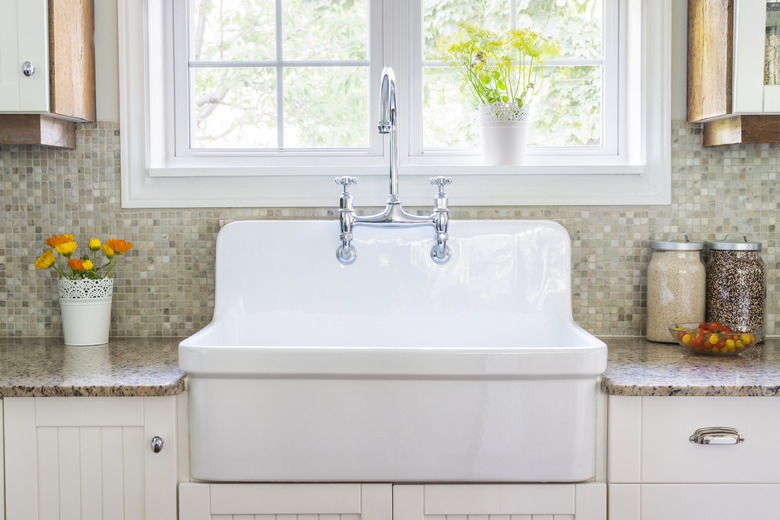How To Remove Stains From A Porcelain Sink
Tough, nonporous porcelain makes an ideal material for sinks. But even though it's easy to clean, porcelain isn't immune to stains. The glaze over the strong porcelain surface can take on stains from hair dye, minerals in the water, nail polish, food and other materials. Regular cleaning helps keep gunk from building up, but stains take a little extra work to restore porcelain sink surfaces. It's important to gently remove the discoloration to avoid scratching the porcelain.
Avoid Harsh Cleaning Products
Avoid Harsh Cleaning Products
Tools that are rough or very abrasive can scratch your porcelain sink. Avoid using those tools so you don't have to reglaze your porcelain sink surfaces. Products that would scratch glass can also scratch porcelain, which can help you decide what to use and what to avoid.
Antique porcelain sinks are particularly susceptible to scratching or damage from harsh chemicals. If your sink is any color other than white, you also need to be careful with cleaning products. Avoid anything abrasive or containing bleach.
Wash the Sink
Wash the Sink
Thorough cleaning with standard liquid soap helps remove any built-up soap scum, dirt and other debris. This helps those things from setting in and gives you a clean slate so you can see the stain fully. Use a nonabrasive sponge to work the soap and water into the porcelain. Rinse away the soap bubbles well.
Use Bleach on White Porcelain
Use Bleach on White Porcelain
Bleach is safe to use on white porcelain as long as it's not a vintage porcelain sink. Chlorine bleach is potentially damaging to older porcelain and sinks with color. Pour the bleach in a spray bottle for controlled application.
For this porcelain sink care trick, line the sink with paper towels. Spritz the bleach onto the paper towels so they're saturated. This holds the bleach onto the stained areas so it can work on them.
Give the bleach at least 30 minutes to remove the stains. Remove the paper towels carefully to avoid dripping bleach on other surfaces. Rinse out the porcelain sink to wash away the remaining bleach.
Use Hydrogen Peroxide on Colors
Use Hydrogen Peroxide on Colors
Instead of using bleach on colored or vintage porcelain, use hydrogen peroxide, which is gentler. Use the same method of lining the sink with paper towels, saturating it with the peroxide and letting it sit for 30 minutes or longer. You may find that the hydrogen peroxide needs more time to remove the stains.
Use Lemon Juice or Vinegar
Use Lemon Juice or Vinegar
Acids, including lemon juice and vinegar, can help remove metal stains on porcelain sinks. Choose just one acid to use instead of mixing them. Cover the stain with the selected acid, and let it sit for at least five minutes. Rinse away the lemon juice or vinegar as soon as you notice the stain changing color.
Restore a Porcelain Sink With Abrasives
Restore a Porcelain Sink With Abrasives
If you choose to use abrasives on your porcelain sink, use the gentlest options to minimize the risk of scratching. Bar Keepers Friend is a product that can help remove stains, but using it too often can cause damage. If you opt for other abrasive cleaners, read the labels to ensure they're safe for porcelain surfaces. Test out the product first to look for potential damage.
Baking soda is a natural, gentle abrasive material you can use on porcelain sinks. To use, turn it into a paste with a little warm water. The baking soda paste may also help remove minor scuffing on the porcelain surface. Rub it into the affected areas with a soft sponge and rinse it away completely.
